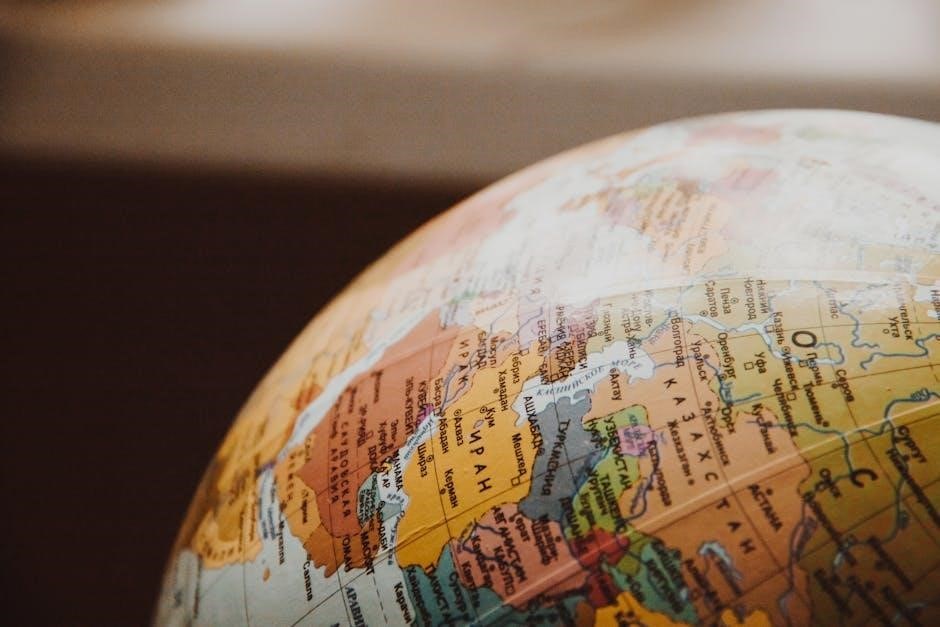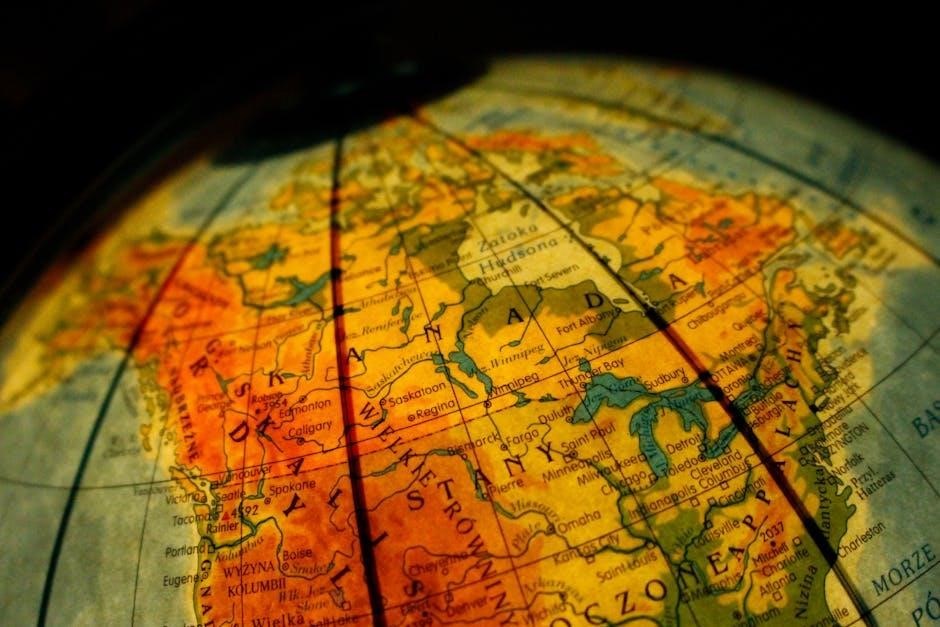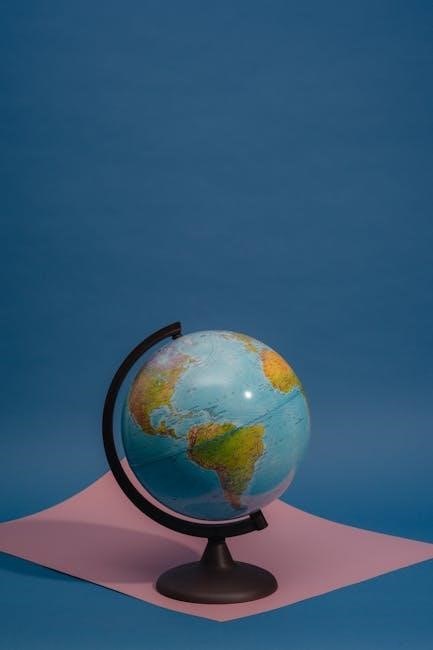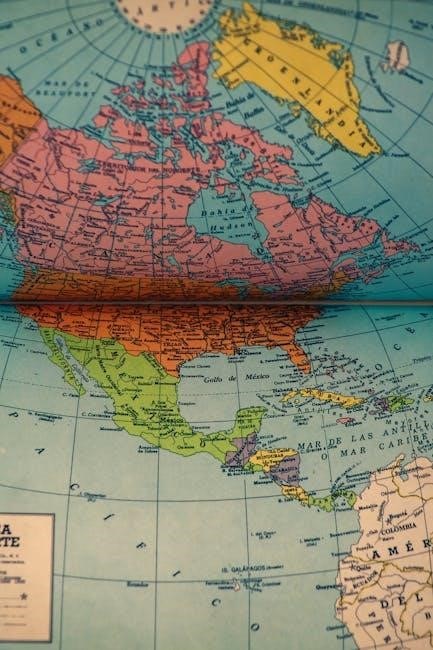ap world unit 1 study guide
This study guide covers the period c. 1200 to c. 1450, focusing on key regions like East Asia, the Islamic World, and the Americas.
Unit 1: The Global Tapestry explores the interconnectedness of societies from c. 1200 to c; 1450, highlighting cultural, political, and economic developments across the world. This period saw the rise of powerful empires, advancements in technology, and the exchange of ideas through trade networks like the Silk Road and Indian Ocean routes. Key regions of focus include East Asia, the Islamic World, South Asia, the Americas, sub-Saharan Africa, and Europe. The study of this era emphasizes how global interactions shaped local cultures, leading to a diverse yet unified global tapestry that laid the foundation for future developments.
Chronological Overview: c. 1200 to c. 1450
The period from c. 1200 to c. 1450 was marked by significant transformations worldwide. In East Asia, the Song Dynasty gave way to the Yuan and Ming dynasties, while Japan experienced the rise of the samurai. The Islamic Golden Age flourished under the Abbasid and Umayyad Caliphates, driving scientific and cultural advancements. In the Americas, pre-Columbian civilizations like the Aztecs and Mayans reached their zenith. Meanwhile, Europe navigated the Late Medieval Period, recovering from the Black Death. This era also saw the expansion of trade networks and the spread of diseases, shaping global connections and laying the groundwork for future empires.

East Asian Developments
China’s Song Dynasty advanced technology and culture, while the Ming Dynasty later restored unity. Japan saw feudalism rise under the Kamakura and Muromachi shogunates, shaping samurai influence.
The Song Dynasty: Technological and Cultural Advancements
The Song Dynasty (960–1279) was a period of remarkable technological and cultural progress in China. Innovations included gunpowder, the compass, and movable-type printing, which revolutionized global communication. The capital, Kaifeng, became a hub of trade and learning, fostering advancements in medicine, astronomy, and engineering. Cultural achievements flourished, with poetry, calligraphy, and landscape painting reaching new heights. The Song also saw the rise of a robust maritime trade network, connecting China to Southeast Asia, India, and beyond. These developments laid the groundwork for China’s influence in global trade and culture during subsequent centuries.
The Ming Dynasty: Reunification and Isolation
The Ming Dynasty (1368–1644) marked a period of reunification and restoration after the Mongol rule. The capital, Beijing, was established, and the Forbidden City was built as a symbol of imperial power. The Ming revived Confucian traditions and promoted agricultural and economic recovery. However, the dynasty also implemented isolationist policies, such as the “haijin” maritime ban, limiting foreign trade and exploration. The Great Wall was fortified to protect against northern invasions. Despite these measures, the Ming faced internal strife and external pressures, eventually leading to its decline. This period highlights the tension between cultural preservation and global engagement.
Developments in Japan: Kamakura and Muromachi Periods
The Kamakura period (1185–1333) saw the rise of the warrior class and the establishment of the Kamakura shogunate, shifting power from the emperor to the military. Buddhism flourished, with the spread of Zen, and samurai culture emerged. The Mongol invasions of 1274 and 1281 were repelled, reinforcing Japan’s isolation. The Muromachi period (1336–1573) began with the Ashikaga shogunate, characterized by political instability and regional conflicts. The Onin War (1467–1477) weakened central authority, leading to a fragmented Japan. This era also saw the growth of trade and cultural exchange, particularly with China, influencing Japanese art and architecture.
The Role of the Samurai and the Shogunate
The Samurai emerged as a dominant warrior class in Japan, adhering to a strict code of honor known as Bushido. They served as both warriors and administrators, playing a central role in feudal society. The Shogunate, established during the Kamakura period, was the military government that governed Japan, with the Shogun holding actual power while the Emperor retained symbolic authority. The Samurai class supported the Shogunate, which maintained order and controlled regional daimyos (feudal lords). Over time, the Shogunate’s power fluctuated, but the Samurai remained pivotal in shaping Japan’s political and social structures, influencing its cultural identity and institutions during this period.
Mongol Invasions and Their Impact on Japan
The Mongol invasions of Japan in the late 13th century, led by Kublai Khan, had a profound impact on the island nation. Two major attempts to invade Japan in 1274 and 1281 were thwarted by typhoons, known as the “Kamikaze” or “Divine Wind,” which destroyed the Mongol fleets. These failed invasions reinforced Japan’s isolationist tendencies and solidified the Samurai class’s influence. The invasions also prompted Japan to strengthen its military defenses and centralized authority under the Shogunate. Despite the repulsion of Mongol forces, the invasions left a lasting legacy in Japan’s perception of external threats and its strategic defenses.

South Asia and the Islamic World
This section explores the rise of Muslim rule in India under the Delhi Sultanate, the blending of Islamic and local cultures, and the Islamic Golden Age’s scientific advancements.
The Delhi Sultanate: Muslim Rule in India
The Delhi Sultanate, established in 1206, marked the beginning of Muslim rule in India. It was founded by Qutb-ud-din Aibak, a Turkish slave-general, after the Ghurid invasions. The sultans centralized power, introducing Persian administrative practices and Islamic law. They relied on slave-soldiers, or bandagan, to maintain control. The Delhi Sultanate facilitated cultural exchange, blending Islamic traditions with local Indian practices. However, frequent succession struggles and regional rebellions weakened the empire. Despite this, it laid the foundation for later Muslim rule in India, including the Mughal Empire, and promoted advancements in architecture, literature, and trade networks. Its legacy endures in India’s diverse cultural tapestry.
The Syncretic Culture of South Asia
South Asia during this period experienced a blending of cultures, particularly under Muslim rule. The Delhi Sultanate and regional kingdoms fostered syncretism, where Islamic traditions merged with local Hindu and Buddhist practices. This cultural fusion was evident in architecture, such as the Qutub Minar, which combined Islamic designs with Indian motifs. Literature also flourished, with Persian and local languages influencing each other. Sufi mysticism played a significant role, promoting spiritual harmony between Muslims and non-Muslims. This syncretic culture enriched South Asia’s identity, creating a unique heritage that continues to influence art, religion, and society in the region to this day.
The Abbasid and Umayyad Caliphates
The Umayyad Caliphate, established in 661 CE, was the first Islamic dynasty, ruling from Damascus. It expanded Islamic influence across North Africa, Spain, and Central Asia. However, internal conflicts led to its decline. The Abbasid Caliphate, which succeeded it in 750 CE, shifted the capital to Baghdad, becoming a center of learning and culture. The Abbasids oversaw significant advancements in science, mathematics, and philosophy, preserving Greek and Roman knowledge. Their reign marked the Islamic Golden Age, fostering intellectual and cultural achievements that profoundly impacted global civilization. The Abbasid Caliphate lasted until 1258 CE, leaving a lasting legacy in Islamic society.
The Islamic Golden Age: Scientific and Cultural Achievements
The Islamic Golden Age, spanning the 8th to 14th centuries, was a period of remarkable scientific, cultural, and philosophical advancements. Scholars in the Abbasid Caliphate translated and preserved ancient Greek, Roman, and Persian texts, laying the groundwork for later European Renaissance. Innovations in mathematics, such as algebra, and astronomy, like the development of the astrolabe, were pioneered. Medical advancements by figures like Ibn Sina and Ibn Rushd revolutionized healthcare. Cultural achievements included poetry, architecture, and art, with landmarks like the Alhambra in Spain. This era of intellectual flourishing had a profound and lasting impact on global knowledge and culture.
The Spread of Islam and Its Impact on Trade and Culture
Islam spread rapidly across the Middle East, North Africa, and beyond, facilitated by trade networks and conquests. The faith integrated with local cultures, creating a rich syncretic tradition. Cities like Baghdad and Damascus became hubs of commerce and cultural exchange, linking the Mediterranean to the Indian Ocean. Muslim traders and scholars played a crucial role in the Silk Road and maritime trade, exchanging goods, ideas, and technologies. This exchange fostered cultural blending, as seen in the art, architecture, and intellectual traditions of regions like al-Andalus in Spain. Islam’s spread also unified diverse societies under shared religious and legal frameworks, shaping global trade patterns and cultural identities.

The Americas
The Americas saw the rise of complex civilizations like the Aztecs and Mayans, who developed advanced systems of astronomy, mathematics, and agriculture, shaping their cultures and societies.
Pre-Columbian Civilizations: Aztecs and Mayans
The Aztecs and Mayans were prominent pre-Columbian civilizations in Mesoamerica. The Aztecs established a powerful empire centered in Tenochtitlán, with advanced political and religious systems. Their capital was a marvel of engineering, featuring floating gardens and a sophisticated drainage system. The Mayans, known for their expertise in astronomy and mathematics, developed a complex writing system and built elaborate cities like Chichen Itza and Tikal. Both civilizations relied heavily on agriculture, particularly maize, and their cultures were deeply intertwined with religious and mythological beliefs. Their achievements laid the foundation for later cultural and technological developments in the region.
The Aztec Empire: Political and Religious Structures
The Aztec Empire was a highly centralized state ruled by an emperor, believed to be divine. The capital, Tenochtitlán, was the political and religious center, with a powerful priesthood overseeing religious rituals. The empire expanded through military conquest and alliances, with local rulers allowed autonomy in exchange for tribute. Religion dominated Aztec life, with human sacrifices to appease gods like Huitzilopochtli. The Aztecs also developed a system of writing and record-keeping using pictographs and hieroglyphs. Their religious structures, such as the Templo Mayor, symbolized their complex cosmology and reinforced the empire’s authority over its diverse population.
Maya Civilization: Astronomy, Mathematics, and Architecture
The Maya excelled in astronomy, creating precise calendars like the Tzolkin and Haab to track celestial movements. Their mathematical system used a base-20 framework with a concept of zero, aiding in advanced calculations. Architectural achievements include grand cities like Tikal and Chichen Itza, featuring pyramids and temples aligned with astronomical events. These structures showcased their sophisticated engineering skills and deep understanding of geometry. Their knowledge significantly influenced later Mesoamerican cultures, leaving a lasting legacy in science and architecture that continues to inspire wonder and study today.

Sub-Saharan Africa
The Mali Empire thrived under Mansa Musa, renowned for the gold-salt trade and his pilgrimage. Timbuktu became a hub of learning and cultural exchange.
Kingdoms and Empires: Mali and Songhai
The Mali Empire emerged as a dominant force in West Africa, thriving due to its strategic location and control of the gold-salt trade. The empire expanded under powerful rulers like Sundiata Keita, who established a strong centralized government. The Songhai Empire later rose to prominence, absorbing much of the Mali Empire’s territory. Both kingdoms relied on military strength and efficient administrative systems. Their capitals, such as Niani for Mali and Gao for Songhai, became centers of commerce and culture, facilitating the exchange of goods and ideas across the Sahara.
The Mali Empire: Mansa Musa and the Gold-Salt Trade
Mansa Musa, the legendary ruler of the Mali Empire, famously showcased its wealth during his 1324 pilgrimage to Mecca. The empire’s prosperity stemmed from controlling the gold-salt trade, with salt mined in Taghaza and gold from Bure. Trade routes connected Mali to North Africa and beyond, fostering economic growth. Mansa Musa’s reign marked a golden age, with cities like Timbuktu and Djenné flourishing as centers of Islamic scholarship. His lavish spending during the hajj highlighted Mali’s wealth, solidifying its reputation as a major power in West Africa during the medieval period.
The Role of Timbuktu as a Center of Learning
Timbuktu emerged as a premier intellectual hub in the Mali Empire, attracting scholars from across the Islamic world. The University of Sankoré and other madrasas became centers of learning, focusing on Islamic studies, mathematics, astronomy, and medicine. The city’s manuscripts, preserved in libraries, highlight its role in preserving and advancing knowledge. Timbuktu’s scholars contributed significantly to African and Islamic intellectual traditions, establishing it as a beacon of education and cultural exchange during the medieval period.
The Mongol Empire
The Mongol Empire, under Genghis Khan and successors, expanded rapidly, creating the largest contiguous empire in history. Their military prowess and administrative systems facilitated global trade and cultural exchange.
The Mongol Empire’s Impact on Global Trade and Culture
The Mongol Empire facilitated global trade through the Silk Road, fostering economic and cultural exchange between East Asia, the Middle East, and Europe. Their administrative systems, like the Pax Mongolica, ensured stability and security for merchants. The empire’s vast networks enabled the spread of technologies, such as gunpowder, and cultural practices. Buddhism, Islam, and Christianity interacted more freely under Mongol rule. The Mongols also promoted tolerance and syncretism, blending diverse cultures. However, their decline led to regional fragmentation. The Mongol Empire’s legacy lies in its role as a cultural and economic bridge, shaping global connections that endured beyond its collapse.
Europe
Europe during c. 1200–c. 1450 saw the rise of city-states like Venice and Milan, fostering economic growth and cultural advancements. Feudalism dominated rural areas, while the Black Death caused significant social and economic disruption, reshaping European society and labor systems.
The Late Medieval Period: City-States and Feudalism
During the late medieval period, Europe was characterized by the coexistence of city-states and feudal systems. City-states like Venice and Milan flourished as centers of trade and culture, while feudalism dominated rural areas. Lords and vassals maintained hierarchical relationships, with peasants tied to the land. This dual structure influenced political, economic, and social dynamics. City-states fostered innovation and economic growth, while feudalism preserved traditional hierarchies. This period laid the groundwork for the transition to early modern Europe, balancing between centralized authority and regional autonomy. The interplay between these systems shaped Europe’s development during this transformative era.
The Black Death: Social and Economic Impact
The Black Death, which swept through Europe in the 14th century, caused unprecedented devastation. It led to significant social and economic changes. The drastic reduction in population disrupted feudal systems, as labor shortages gave peasants more bargaining power. This contributed to the decline of serfdom and the rise of a wage-based economy. Socially, the plague created widespread fear and mistrust, leading to increased religious fervor and persecution of minority groups. Economically, the shift in labor dynamics spurred technological innovation and reshaped the structure of European society, laying the groundwork for the Renaissance and early modern development.

Global Interactions
Global interactions during this period were shaped by trade networks like the Silk Road and Indian Ocean Trade, facilitating the exchange of goods, ideas, and cultures, while fostering economic growth and cultural diffusion across vast regions.
Trade Networks: The Silk Road and Indian Ocean Trade
The Silk Road and Indian Ocean Trade were vital networks connecting Eurasia and Africa, facilitating the exchange of goods like spices, textiles, and porcelain. These routes also spread ideas, religions, and technologies, fostering cultural and economic ties between civilizations. Merchants and traders played a crucial role in these systems, while maritime trade in the Indian Ocean linked East Africa, the Middle East, and South Asia. The Silk Road, both overland and maritime, enabled the transfer of goods and knowledge, shaping global connections and fostering prosperity in regions like China, India, and the Islamic World during this period.
The Spread of Diseases and Their Global Consequences
The spread of diseases during this period, particularly the Black Death, had devastating global consequences. Originating in Central Asia, the plague spread rapidly along trade networks like the Silk Road and Indian Ocean routes, reaching Europe, Asia, and Africa. It caused unprecedented mortality, with estimates suggesting millions of deaths. The demographic collapse led to significant social and economic changes, including labor shortages, shifts in feudal systems, and increased social unrest. The pandemic also disrupted trade and cultural exchange, while fostering widespread fear and persecution of minority groups. Its impact reshaped societies and economies, leaving a lasting legacy in global history.

Technological and Cultural Innovations
Advances like gunpowder and maritime technologies reshaped warfare and trade. Cultural innovations in metallurgy, engineering, and architecture flourished, driving global progress and interconnectedness during this period.
The Spread of Gunpowder and Maritime Technologies
The spread of gunpowder revolutionized warfare globally, originating in China and diffusing to the Middle East and Europe. Maritime technologies, such as the astrolabe and lateen sails, facilitated oceanic exploration and trade. These innovations interconnected regions, fostering cultural and economic exchanges. Gunpowder’s military applications reshaped empires, while advanced navigation tools enabled explorers to traverse vast distances. Such technological advancements laid the groundwork for future global dominance and transformed societies politically, socially, and economically, marking a significant era of progress and interconnectedness during this period.
The period c. 1200 to c. 1450 laid the foundation for global interconnectedness, shaping future developments through cultural exchange, technological advancements, and the rise of empires worldwide.
The Legacy of the Global Tapestry: Foundations for Future Developments
The period from c. 1200 to c. 1450 established a global tapestry rich in cultural, technological, and economic advancements. The Song and Ming dynasties in East Asia pioneered innovations like gunpowder and maritime technologies, while the Islamic Golden Age contributed significantly to science and mathematics. The Mongol Empire’s vast trade networks facilitated the exchange of ideas and goods, connecting distant regions. These developments laid the groundwork for future global interactions, shaping the rise of European exploration and the interconnectedness of civilizations worldwide. The legacy of this era is evident in the enduring impact on modern societies and global systems.
